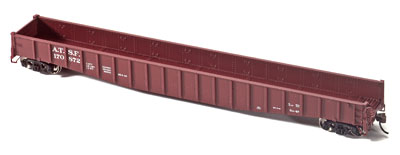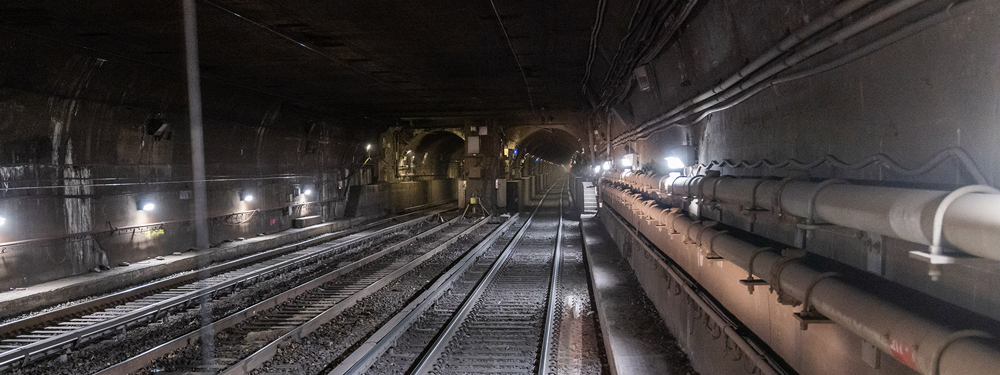Mill gondolas are designed to haul finished steel products such as angles, I-beams, or other structural shapes. All of the bracing is on the outside of the body so the car interior is free of any bracing that might cause damage to the load. The drop ends allow these gondolas to carry loads that are longer than the freight car by letting the steel beams extend out over an accompanying flatcar.
Photographs and prototype plans of this car can be found in the 1943 Simmons-Boardman Car Builders Cyclopedia. The specific prototype is an Atchison, Topeka & Santa Fe class Ga-55 car, built in 1941 by General American Transportation Corp. This car design went on to became the Association of American Railroads (AAR) Car Committee’s recommendation. Copies and similar versions from other builders soon followed on many railroads. Athearn’s new model closely matches the original Santa Fe version.
Car construction. This model is made from an interesting combination of materials. Its sides and ends are flat styrene castings, and the floor is die-cast metal, so most of the weight is low in the carbody.
The floor casting includes the underframe and coupler boxes, so insulated couplers must be used to prevent potential shorts through the couplers. Plastic McHenry magnetic knuckle couplers are included, and they’re mounted at the proper height. The box lids are secured with screws.
An AB brake system is represented with a plastic brake cylinder, air reservoir, and triple valve, but there’s no other brake rigging underneath. Because of the car’s low fishbelly sides, this isn’t apparent. The brake wheel and housing are mounted on a corner of the car.
A combination of molded side ladders, stirrup steps, and 10 formed wire grab irons are individually applied. All of the molded ladders and wire parts have fine cross-sections that add to the model’s realism.
This open-top car’s interior is covered with rivets, and it includes representations of the prototype’s U-shaped, retractable stake pockets along both sides. These fittings hold the side stakes when the prototype car is loaded with wood poles or lumber. Many more rivets appear on the floor along with bolster plates and other reinforcements. The operating drop ends are detailed on both sides.
Our sample car weighs 3 ounces, well below the 5.5 ounces called for in the National Model Railroad Association’s recommended practice of 1 ounce plus ½ ounce per inch of length. Additional weight can easily be concealed by attaching it to the underside near the middle of the floor.
Our sample came with rigid-frame 70-ton ASF type A-3 ride control trucks molded in acetal plastic. However, the original Santa Fe cars had National type B-1 trucks (available from Life-Like). The Athearn wheelsets have RP-25 contour nickel-silver wheels and needlepoint insulated axles that match the NMRA standards. They are very free-rolling.
This early specialized car is an interesting steam-to-diesel transition era model that will be handy for all sorts of long loads.
Price: $19.98 each
Manufacturer
Athearn Inc.
1550 Glenn Curtiss St.
Carson, CA 90746
www.athearn.com
Description: Plastic and metal ready-to-run freight car with drop ends
Road names: Atchison, Topeka & Santa Fe; Chicago, Burlington & Quincy, Erie Lackawanna; New York, Chicago & St. Louis (Nickel Plate Road); Reading; Southern Ry.; undecorated
Features
Die-cast metal floor
Interior details
McHenry magnetic knuckle couplers, mounted at the proper height
Molded plastic body sides, ends, and details
Movable drop ends
Weight: 3 ounces














